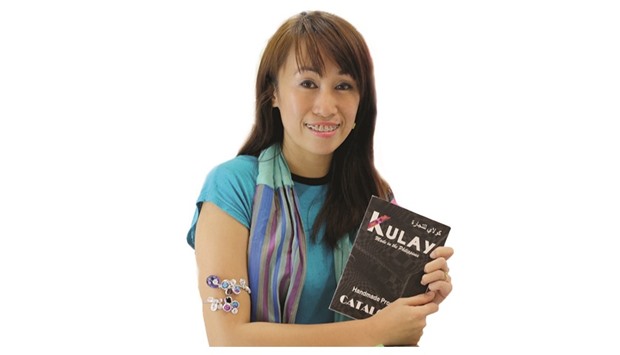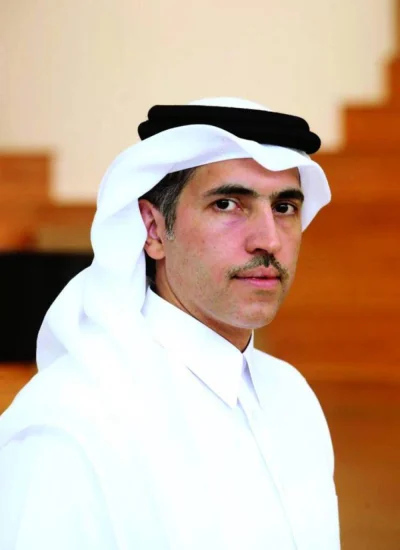Juggling multiple roles, she makes sure the whole act stands out. Starting out as an architect before going on to make a career in interior design, this mother of one has now embarked on an entrepreneurial path. And that too with an entirely new field of fashion design.
Kharelly Sakilan, a Filipino expatriate, showcases her gifted talent for fashion and design besides her unmatched aesthetic sense in the line of clothes, shoes and accessories she recently launched. Kulay (Colour), her boutique in Quality Hypermarket in Al-Hilal, is a showpiece of ethnic Filipino culture and contemporary style.
With the aim to preserve and promote Philippines’ heritage in hand-woven fabric, Kherally involves the ethnic handmade materials sourced from Philippines at every stage of her designing of shoes and apparel for men, women and children.
Her attractive designs and sketches are crafted into stylish clothes, shoes, handbags, clutches and jewelry by some of the finest artisans and weavers from her native Zamboanga city and other areas of Philippines, all handmade.
Through Kulay, Kharelly intends to not just provide a source of revenue to these ethnic communities of artisans; she wants to promote the Filipino culture and artistry in the global fashion industry.
“I decided to choose the ethnic Filipino fabric because I am concerned that our traditional culture is vanishing. We are more into western (culture) now. Ours is a very rich culture, a gift from God,” Kharelly tells Community at her recently opened boutique.
Having an architect’s licence back in Philippines and a degree in interior design, Kharelly is also a self-taught painter. She is mostly into portraits and murals, and there, too, her inspiration is culture and tradition.
She herself designed the catchy interior of her boutique, the catalogue and the signage fixed on the head of her shop.
“Through my designs incorporating the traditional, I am trying to tell people that Filipino traditional apparel is still beautiful and can also be trendy. What attracts me the most in this ethnic fabric is that it has its unique natural patterns. These patterns are exclusively available at Kulay in Qatar,” she says, smiling.
The people involved in the weaving of this fabric and manufacture of shoes are not so well-off. In search of work or for lack of money, they sometimes are forced to move to cities and Kharelly says she does not want them to end up on streets.
Through Kulay, her mission is to help them by purchasing their fabric so that they can continue doing what they have traditionally been doing all their lives.
When she first arrived in Qatar, Kharelly started working as an architect. It was only last year that she struck upon the idea of fulfilling her longtime dream, designing clothes and shoes that have an accent of her ethnic fabric.
This fabric is hand-woven by the native people of villages from different parts of Philippines. The patterns are very unique. She wanted to showcase this kind of patterns in the Gulf countries and the rest of the world.
Kharelly says she sources the fabric through her contacts in Philippines who go to these villages and buy directly from the weavers.
First, she creates the designs in sketches of clothes, shoes and handbags. Then, she sends them to the coordinator in Philippines who gets them manufactured by the local artisans. They keep sending her the samples which she improves until they achieve the perfect piece. Only then it goes to production.
“For instance, it took me three months to finalise a pair of shoes. I use the ethnic fiber and patterns on some of the simple everyday designs to give them a contemporary look while some designs are created from scratch,” says the self-taught designer.
It takes months, she explains, to make it perfect especially the workmanship takes time as it is the artisans’ first experience using the fabric and leather both together in her designed pieces.
The one who makes her shoes is based in Marikina city, a shoe industry hub in Philippines which holds the record of manufacturing the world’s largest shoes, the giant 17 feet long and 8 feet wide dress shoes.
“I chose them for the very fact and also because of their overall popularity for making shoes. I am very strict abut the quality of shoes. Most of my shoes designs use calf leather from Philippines,” she reveals.
For clothes, she similarly sends them the artisan sketches and the specifications about the fabric to be used in the knitting with complete information on which fabric would go to which part of the design and in what colour.
She points to one particular dress hanging in her wardrobe. It is a traditional shoulder top which is made from a fabric that is woven with pineapple fibre. It is traditionally called Filipiniana in Philippines and is usually a long dress worn on special occasions.
“But I cut it short to give it a more modern look. In this form, it can be worn over any kind of clothes and in combination with different colours,” explains Kharelly as she examines the dress in her hands.
Her slogan, she says, is ethnic weave meets global trends. Anybody can use her designs. They are international. The idea is that these Filipino traditional robes can be worn by anyone from any nationality anywhere.
Kharelly says she does not copy designs from anywhere — all of them are original.
Although she has stocked some designs of handbags from other designers that are also done in ethnic fibre, to give them the Kulay signature, she has added her own colourful ribbons to them.
All different kinds of shoes for men, women and children are designed by Kharelly herself and they are indeed striking designs, a combination of funky and sober catalogue.
She has also launched a website for Kulay where people can see the online catalogue and place orders. She says she is also taking bulk orders. Her team can prepare these orders within a month.
On managing time between her different roles and jobs, she says it all just comes together.
“I do not know how I am able to manage it all. I think it is my passion. When I am into something I just lose myself into it and everything just comes together by itself,” says Kharelly.
She lost her job at a consultancy firm in a layoff, but says she has realised she could not have managed her shop with the job. In future, however, she hopes once her business expands and she is able to hire staff, she would want to get back to architecture design, her first love.

DRIVEN: Through Kulay, Kharelly aims to promote and preserve Filipino culture and heritage. Photo by Umer Nangiana

